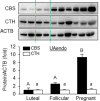Ovine uterine artery hydrogen sulfide biosynthesis in vivo: effects of ovarian cycle and pregnancy†
- PMID: 30772913
- PMCID: PMC6561857
- DOI: 10.1093/biolre/ioz027
Ovine uterine artery hydrogen sulfide biosynthesis in vivo: effects of ovarian cycle and pregnancy†
Abstract
Uterine vasodilation dramatically increases during the follicular phase of the estrous cycle and pregnancy, which are estrogen-dominant physiological states. Uterine vasodilation is believed to be mainly controlled by local uterine artery (UA) production of vasodilators and angiogenic factors. The extremely potent vasodilator and proangiogenic hydrogen sulfide (H2S) is synthesized via metabolizing L-cysteine by cystathionine β-synthase (CBS) and cystathionine γ-lyase (CTH). This study was designed to determine if UA H2S production increases with augmented expression and/or activity of CBS and/or CTH during the ovarian cycle and pregnancy in sheep. Uterine arteries from intact nonpregnant (NP) luteal and follicular phase and late (130-135 days, term ≈ 145 days) pregnant (P) ewes were collected; endothelium-enriched proteins (UAendo) and endothelium-denuded smooth muscle (UAvsm) were mechanically prepared for accessing CBS and CTH proteins by immunoblotting; their cellular localization was determined by semi-quantitative immunofluorescence microscopy. H2S production was measured by the methylene blue assay. Immunoblotting revealed that CBS but not CTH protein was greater in P > > > NP follicular > luteal UAendo and UAvsm (P < 0.001). H2S production was greater in P > > > NP UAendo and UAvsm (P < 0.01). Pregnancy-augmented UAendo and UAvsm H2S production was inhibited by the specific CBS but not CTH inhibitor. CBS and CTH proteins were localized to both endothelium and smooth muscle; however, only CBS protein was significantly greater in P vs NP UA endothelium and smooth muscle. Thus, ovine UA H2S production is significantly augmented via selectively upregulating endothelium and smooth muscle CBS during the follicular phase and pregnancy in vivo.
Keywords: cystathionine β-synthase; hydrogen sulfide; in vivo; ovarian cycle; pregnancy; sheep; uterine artery.
© The Author(s) 2019. Published by Oxford University Press on behalf of Society for the Study of Reproduction.
Figures





References
-
- Ford SP, Reynolds LP, Magness RR. Blood flow to the uterine and ovarian vascular beds of gilts during the estrous cycle or early pregnancy. Biol Reprod 1982; 27:406–411. - PubMed
-
- Magness RR, Ford SP. Estrone, estradiol-17 beta and progesterone concentrations in uterine lymph and systemic blood throughout the porcine estrous cycle. J Anim Sci 1983; 57:449–455. - PubMed
-
- Magness RR, Rosenfeld CR. The role of steroid hormones in the control of uterine blood flow. In: The Uterine Circulation. Perinatology Press, Ithaca, NY; 1989; 10:239–271.
-
- Magness RR, Rosenfeld CR. Local and systemic estradiol-17 beta: effects on uterine and systemic vasodilation. Am J Physiol 1989; 256:E536–E542. - PubMed
-
- Rosenfeld CR, Chen C, Roy T, Liu X. Estrogen selectively up-regulates eNOS and nNOS in reproductive arteries by transcriptional mechanisms. J Soc Gynecol Invest 2003; 10:205–215. - PubMed

